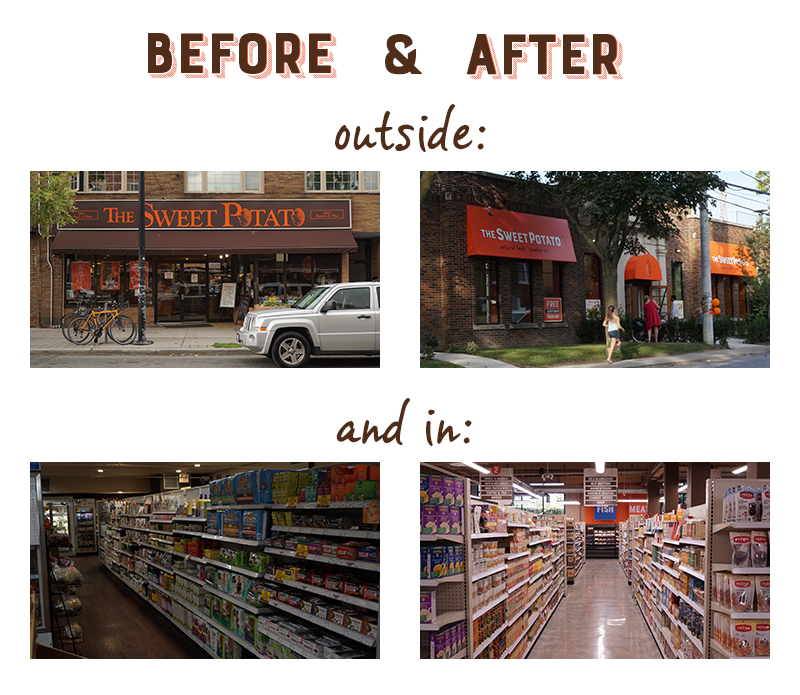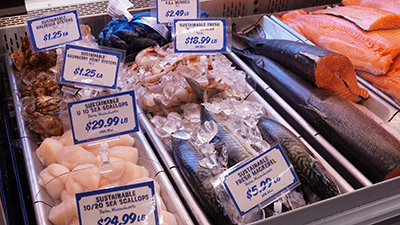Well, it’s been seven months since we moved into our swanky new digs at Vine Ave, and while it’s quite obvious how much prettier than our old location our new Vine Ave. location is,what may be less obvious is all the ways we’ve tried to make our Vine Ave location better for the world as part of our commitment to environmental stewardship.

In honour of Earth Day, we’re documented the top five ways we’re living out our environmental values:
- More environmentally responsible equipment
-
- The ORCA! Seriously, this guy is amazing. The ORCA is a made-in-Toronto innovation
 that sustainably processes food waste. A bunch of times a day, we feed the ORCA most organic waste materials we have – like peelings and stems, floor found bulk, and old bread – and it rapidly composts them, turns them into liquid (!!!), and sends the liquid into the sewage system. This whale of a machine diverts food waste disposal from landfills AND reduces methane gas production.
that sustainably processes food waste. A bunch of times a day, we feed the ORCA most organic waste materials we have – like peelings and stems, floor found bulk, and old bread – and it rapidly composts them, turns them into liquid (!!!), and sends the liquid into the sewage system. This whale of a machine diverts food waste disposal from landfills AND reduces methane gas production. - Our fridge system. We love our fridge system. We’ve told you about it before. But seriously, it’s the best. It’s giant, looks like it comes from a science fiction movie, and micromanages all of our fridges and freezers, recycling hot and cold water from the massive refrigeration system to help keep the store cool in the summer and comfy in the winter! Energy efficiency is sexy.
- LED and recycled lights. All the light fixtures on the retail floor are LED, and all the ones in the back are recycled lights. We hope to get our back rooms lit by LED soon, too!
- And more! Moving meant upgrading all kinds of equipment, and we really tried to make it all waaaaay more efficient. Highlights include: new kitchen equipment that lets us heat things up in ten minutes that at Dundas took us two hours (cringe); our swanky energy-efficient heating, ventilating, and air conditioning (HVAC) system; and our sweet new cash systems.
- The ORCA! Seriously, this guy is amazing. The ORCA is a made-in-Toronto innovation
- Way less packaging – one of the cool things about being bigger is that we can be pickier about packaging due to increased selection. Our two fave examples of this are:
-
- Our fish and meat counter. Before the advent of our beloved counter, all meat had tobe individually packed in plastic. Now, we wrap everything in paper – to your request, and so use way less packaging.

- Our bulk department (which has grown 400%!) now encourages taring – for tips on how to shop litterless in the bulk aisle, check out this blog post.
- Our fish and meat counter. Before the advent of our beloved counter, all meat had tobe individually packed in plastic. Now, we wrap everything in paper – to your request, and so use way less packaging.
- Reducing food waste and addressing food insecurity – No waste. No hunger.
-
- We’ve always been committed to addressing both environmental and social problems in our city by donating food to Sistering – a multi-service agency for at-risk, socially isolated women in Toronto who are homeless or precariously housed – most days of the week.
- Because we’re so much bigger now, we’ve recently added Second Harvest’s Food Rescue program to our list of partners, so we can make sure as much of our food waste as possible goes to humans not landfills.
- Supporting our staff to reduce their carbon footprint.
-
- We love our staff. They’ve always been a big part of living our values, but at Vine we’re trying harder than ever to support and encourage them to do their part for the environment. How do you get to work? It’s one of the easiest ways you can affect environmental change. At Vine, we not only have indoor bicycle parking, but we also have a bike-to-work incentive for our staff. If you bike to work a certain number of days (or kilometres) per month, you get cash to use towards bike repairs or purchases. 14% percent of our staff are using this program, and we’re already hearing from them that we need waaaay more bike parking!
- Using our influence – one of the biggest ways we can affect environmental change now more than ever is through our purchasing power. As we buy and sell more, we have more influence in asking companies and farmers to produce and sell more organic products.
And this is just where we are right now. We are far from perfect! We know there’s tons more we can do – from adding solar panels to our roof, to going 80% paperless in our back room, to putting UV/Heating control tint on our windows, to adding daylight-sensitive dimming powers to lights, to getting an e-truck to transport our produce purchases. Reducing our carbon footprint is a messy, complex, and long-term project. But we’re committed to it, we’re working on it, and we sure do think we’re going in the right direction.
